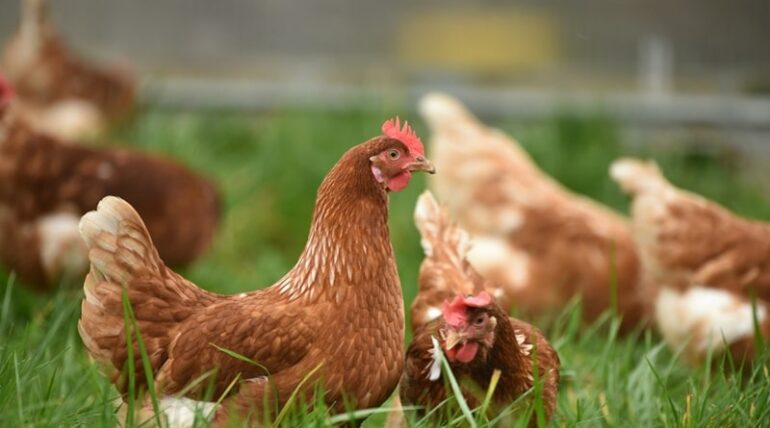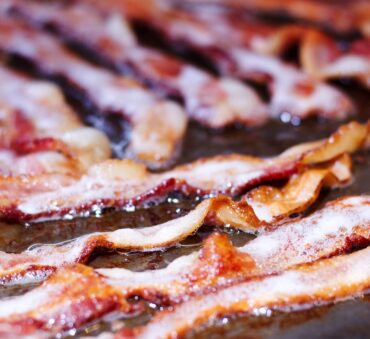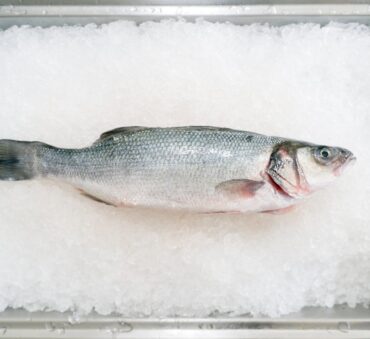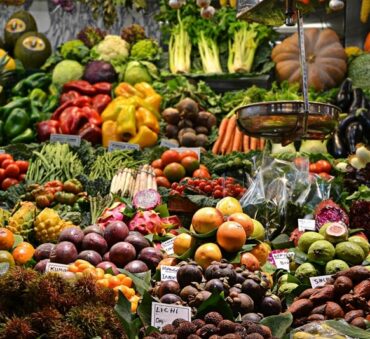One-third of all food produced globally is lost or wasted, resulting in 1 billion tons of food wasted every year.
These shocking food waste statistics show the importance of creating comprehensive waste management strategies to reduce the environmental, economic, and social implications of food waste. In the search for new solutions, chickens have emerged as a potential strategy for households and businesses. But how do chickens reduce food waste?
Chickens can support an upcycling strategy by turning food items that would otherwise be wasted into protein for energy. Keep reading to learn the value of chickens in sustainable waste management, what food waste chickens can eat, and how to convert food waste to chicken feed.
Key Takeaways
- Chickens promote a circular economy by turning kitchen scraps into protein for energy, which not only minimizes waste but also provides households with fresh, locally sourced eggs and poultry.
- Using chicken manure as fertilizer helps provide essential nutrients to your plants and improves the organic matter in your soil, supporting sustainable gardening practices.
- Food waste technology helps convert food waste to chicken feed by providing new strategies to reduce waste on a larger scale. This includes fermentation technology, drying methods, and complying with regulations.
- A change in policies is required to support the use of food waste as chicken feed, which may include implementing new policies, establishing clear regulations, improving research, and providing incentives.
The Value of Chickens in Sustainable Waste Management
Chickens support sustainable living practices by diverting waste from landfills and transforming food scraps into valuable resources. Since food is the single largest category of material placed in municipal landfills presents a unique opportunity to reduce the environmental impact of landfill use and promote a circular economy.
This strategy shows great potential for reducing household food waste, as a large portion of overall waste is generated in households due to over-purchasing, improper food storage, and the misinterpretation of expiration dates.
The same is true for businesses that generate organic waste, empowering them to create large-scale efforts for food establishments or small-scale chicken programs for corporate offices. Since businesses and organizations play a big role in reducing waste, as mentioned in our food waste management guide, it helps set new standards in their industry and community.
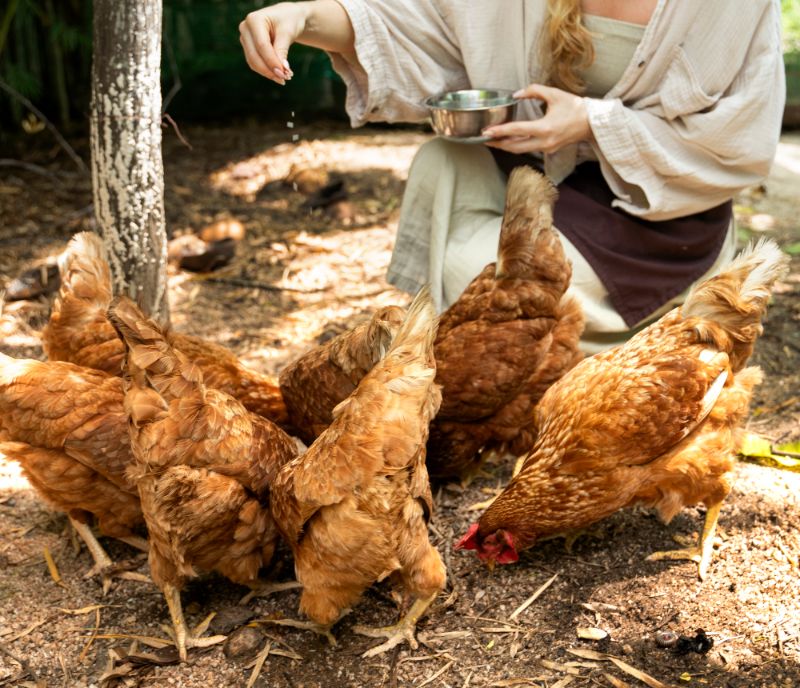
By incorporating chickens into food waste management strategies, individuals and businesses can reduce their environmental footprint while simultaneously benefiting from the resources they provide.
An example of this is the Belgium chicken experiment, which explores the potential of chickens and food waste. Belgium has had multiple government-led programs that offer free or discounted chickens to community members as part of a food waste reduction strategy. In 2010, the town of Mouscron gave away 50 pairs of hens to local households. In 2015, Etterbeek began its own program with backyard chickens. In Diest, 2,000 families collected three free chickens. The result?
Organic waste was cut down significantly, and the families gained a free source of fresh eggs. These programs show the potential of integrating chickens into residential settings, demonstrating the effectiveness of using chickens to reduce food waste in households.
The Circular Economy of Feeding Chicken Food Waste
Fighting food waste with a circular economy focuses on avoiding waste and reusing and regenerating materials or products to preserve their value. So how are a circular economy, chickens and food waste related?
It’s simple. Households and businesses produce waste; waste is given to chickens as feed; chickens produce eggs.
In other words, chickens promote a circular economy by turning kitchen scraps into protein for energy, which not only minimizes waste but also provides households with fresh, locally sourced eggs and poultry. In fact, a recent study compared the quality of eggs that were produced by chickens that were fed recycled food waste-based feed to those who had a standard diet.
The results showed that chickens that consumed food waste maintained egg production while improving feed efficiency compared to those who had a standard diet, demonstrating the potential of food waste as an alternative feed ingredient.
As we’ll see below, eggs aren’t the only way to keep valuable resources in circulation. Chicken manure also acts as a great fertilizer once it’s been properly composted. learn more about the process of composting organic food waste.
Impact on Soil Health and Garden Productivity
Using chicken manure as fertilizer helps provide essential nutrients to your plants and improves the organic matter in your soil, supporting sustainable gardening practices. When compared to other manures, chicken manure is higher in nitrogen, potassium, phosphorus, and calcium and is also rich in organic matter.
To turn chicken manure into an organic fertilizer, follow these steps:
- Collect the manure: The first step to turning chicken manure into fertilizer is the careful collection of manure, using gloves to ensure safety. When collecting, you can also collect associated litter, such as wood shavings.
- Layer green and brown material: Layer the manure (green material) with other organic materials such as leaves or grass clippings (brown material). The ratio should be 1 part manure for 2 parts brown material.
- Take care of the compost pile: Add moisture to the pile as necessary. It should have enough moisture to be about as wet as a wrung-out sponge. The combination of moisture and layered green and brown material produces a hot pile, which is crucial in killing bacteria. The pile should maintain a temperature of 130°F to 150°F for 3 days before it starts to cool. Once it cools, turn the compost pile to bring the outside materials to the center, and vice versa. Repeat this entire process until the compost is dry.
- Cure the compost: Once ready, loosely cover and let sit for up to 60 days before using. You’ll know it’s ready when the material is dark, crumbly, and has an earthy aroma.
- Add to garden: Spread the compost evenly over the garden beds or work it into the existing soil.
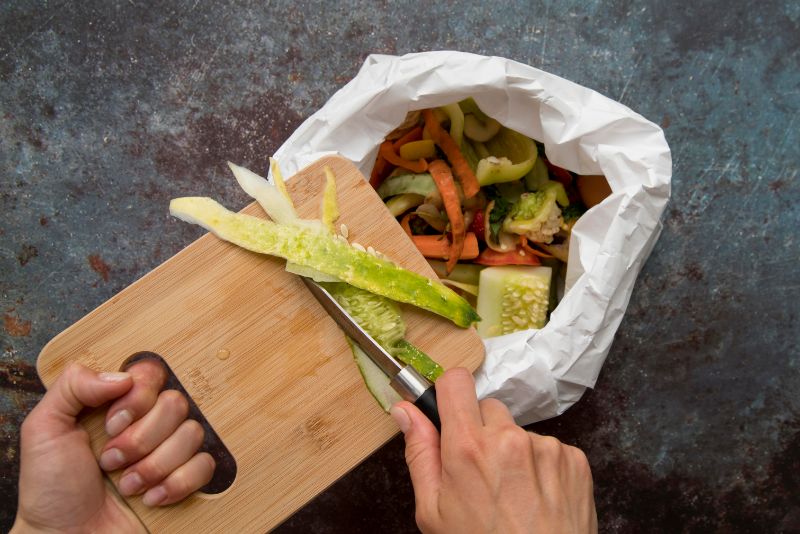
Converting Food Waste into Chicken Feed
Repurposing food waste into nutritious chicken feed fosters sustainable practices while optimizing poultry nutrition. So, what do you need to know to get started?
The complexity of this process depends on the goal of the household or business. In general, households and businesses that have small-scale operations can turn food waste to chicken feed with a quick and easy process. All you need to do is collect the scraps, sort out any materials that cannot be consumed by chickens (we’ll discuss this more below), and process them to make them easier to consume, which may include chopping them into smaller pieces. It can then be given directly to chickens or mixed into their standard diet.
Businesses and organizations that want to create a product that they can put on the market, on the other hand, have stricter regulations. This process starts with the systematic collection of food waste from various sources. This waste is then sorted into organic and non-organic waste. The organic waste is checked again for any non-organic materials and separated based on its suitability for various animals. The waste then undergoes treatment and conversion, which may include ensiling (fermentation), rendering (cooking), or drying.
The feed must be carefully treated and tested for quality and nutritional value, as it must comply with federal laws to ensure quality, therefore protecting the health of animals.
Aside from a new revenue stream, converting food waste to animal feed offers many environmental benefits, making it a sustainable solution for businesses and households alike.
What Food Waste Can Chickens Eat?
Can chickens eat food waste? Do chickens eat table scraps?
These are common questions when people start their journey involving chickens and food waste. And the answer to both is “yes.”
In fact, kitchen scraps can be a great addition to a chicken’s diet, with their diet consisting of a variety of food items that individuals consume in their everyday lives. To ensure a balanced and nutritious diet for optimal chicken health, you can feed your chickens:
- Fruits: Apples, berries, tomatoes, cucumbers, watermelons
- Vegetables: Broccoli, brussels sprouts, cabbage, carrots
- Grains: Rice, wheat, oatmeal
- Greens: Lettuce, kale, chard, spinach
- Bread: Bread and bread-like products, such as pasta, are healthy in moderation
- Cooked meats: Beef, pork, chicken, fish
- Squash: Pumpkins, spaghetti squash, zucchini
- Starches: Corn, peas, potato, sweet potato
*This list contains examples of each food group but is not limited to the examples listed. If you’re unsure about a food item that isn’t listed above, please check the safety of feeding it to your chickens.
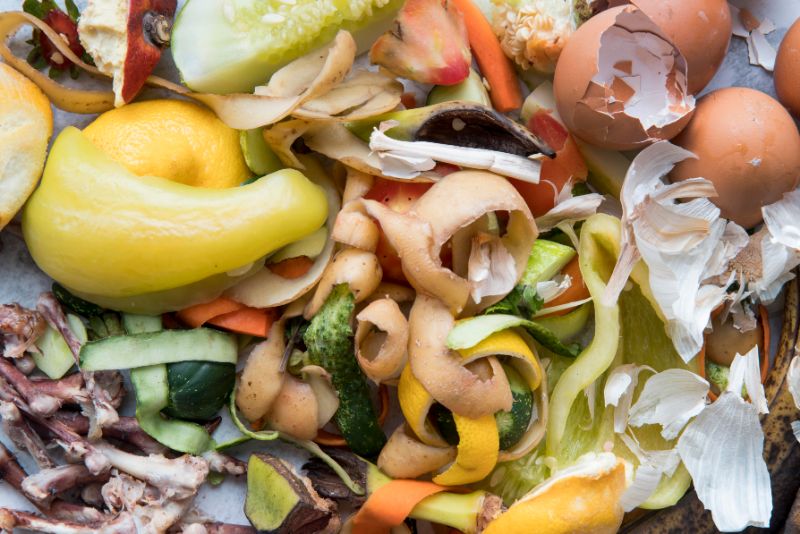
What Food Waste Should Be Avoided?
Though part of the reason chickens reduce food waste is due to their diverse diet, which includes many everyday items, there are some foods that should be avoided. By ensuring that these foods are not part of their diet, you can better maintain the health and well-being of your chickens.
Foods that should be avoided include:
- Moldy or spoiled foods: Just like humans, spoiled foods can cause illness in chickens when consumed. A good rule of thumb is to not feed them anything you wouldn’t eat yourself.
- Avocado pits and skins: Avocado pits and skins contain a toxin called persin, which can be fatal to chickens.
- Processed foods: Chickens can have processed foods occasionally, but they should generally avoid highly processed foods, as they are hard to digest.
- Caffeine: Caffeine, such as coffee grounds and soda, can cause caffeine toxicity, leading to serious health complications.
- Chocolate: Chocolate contains theobromine and caffeine, which are toxic to chickens and can lead to death.
- High-sodium items: In general, salt found in kitchen scraps is okay to give to your chickens. However, excess salt should be avoided to prevent health issues.
- Raw potato peels: Potatoes contain solanine, a toxin that can upset your chickens’ digestive system, leading to diarrhea and vomiting. Please note that this does not include sweet potatoes.
Innovations in Food Waste to Chicken Feed Conversion Technologies
An increased interest in chickens reducing food waste has led to improved conversion methods and technology that streamline the process and improve resource utilization. Food waste technology has made a significant impact on this journey, providing new strategies to reduce waste on larger scales.
Fermentation, for instance, is a common conversion technique that enhances digestibility and nutrient availability for animals. To streamline this process, fermentation technology uses microorganisms and enzymes to break down complex compounds in food waste, offering a promising solution for repurposing food waste into animal feed.
Drying methods have also improved, allowing farmers and businesses to minimize waste and reduce environmental impact. There are multiple ways that food waste can be dried for animal feed, including solar drying, spray drying, dehydration, freeze drying, and microwave drying.
Overall, food waste technology assists in the collection, treatment and recycling, and prevention of food waste. Individuals and businesses interested in improving their sustainability efforts can use advanced technology to optimize collection efforts, create unique treatment solutions, and monitor the conversion of food waste to chicken feed for optimal outcomes. This is especially important for businesses that must follow strict regulations, as monitoring tools help improve the quality and safety of animal feed.
Legal Considerations
Laws regarding chickens may vary depending on the state, county, or even your unique homeowner association rules. That said, common restrictions and regulations may specify the number of chickens allowed, noise regulations, the presence of a rooster, and the size, type, and location of the chicken coop. There may also be permits and fees associated with backyard chickens.
Health and safety guidelines for integrating chickens into food waste reduction strategies must also be considered, such as disease prevention, hygiene practices, food safety, and animal welfare.
Businesses that create animal feed for sale have stricter regulations than backyard chickens. Though regulations vary by state, this includes the Animal Feed Regulatory Program Standards (AFRPS), the FDA’s Bovine Spongiform Encephalopathy (BSE)/Ruminant Feed Ban Rule, Regulations Regarding Labeling and Adulteration, and more. These laws and regulations are outlined here.
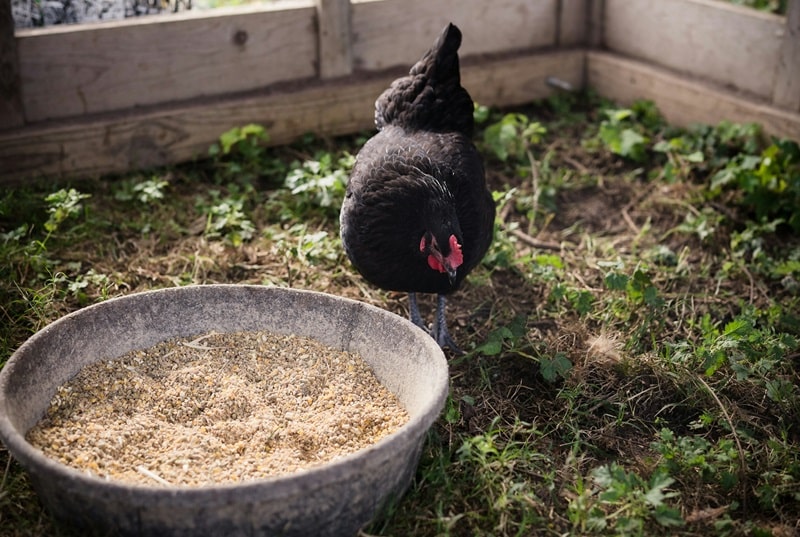
Future Directions and Policy Implications
So, what does the future of chickens and food waste look like?
While chickens show great potential in the waste management sector, there needs to be a change in policies to support the use of food waste as chicken feed.
Unfortunately, due to the limited laws and regulations designed to prevent the spread of animal diseases through the feeding of food waste, only 5–10% of available food waste in the U.S. and European Union is used in animal feeds. This shows the dire need to redesign the global economy to reduce food loss and waste and upcycle ingredients in a circular economy.
While some laws have been implemented to reduce food waste, there needs to be a shift in old laws, allowing food waste to be more easily converted to animal feed. Overall, implementing policies, establishing clear regulations, and providing incentives are all ways to increase widespread adoption of this practice.
There’s also potential for future research areas, such as assessing the nutritional content of different types of food waste, developing effective feed formulations that incorporate food waste, and further investigating the health and safety of this practice.
Wider adoption of chickens reducing food waste can have a long-term impact, offering environmental benefits and economic opportunities. As this waste management strategy gains more attention, we hope to see a shift in regulations that promotes a circular economy.
Conclusion
Turning food waste to chicken feed is a comprehensive waste management strategy that helps divert waste from landfills and reduce the environmental and economic consequences of food waste. If you’re interested in exploring this approach, having an external partner with years of experience managing this complex process will help streamline the process and provide optimal results.
At Shapiro, we provide industrial food waste recycling solutions to a range of businesses and industries. Our use of advanced technology combined with years of experience allows us to create tailored solutions for each individual client.
If you’re ready to start reducing food waste and converting waste to animal feed, contact us today.
Baily Ramsey, an accomplished marketing specialist, brings a unique blend of anthropological insight and marketing finesse to the digital landscape. Specializing in educational content creation, she creates content for various industries, with a particular interest in environmental initiatives.
